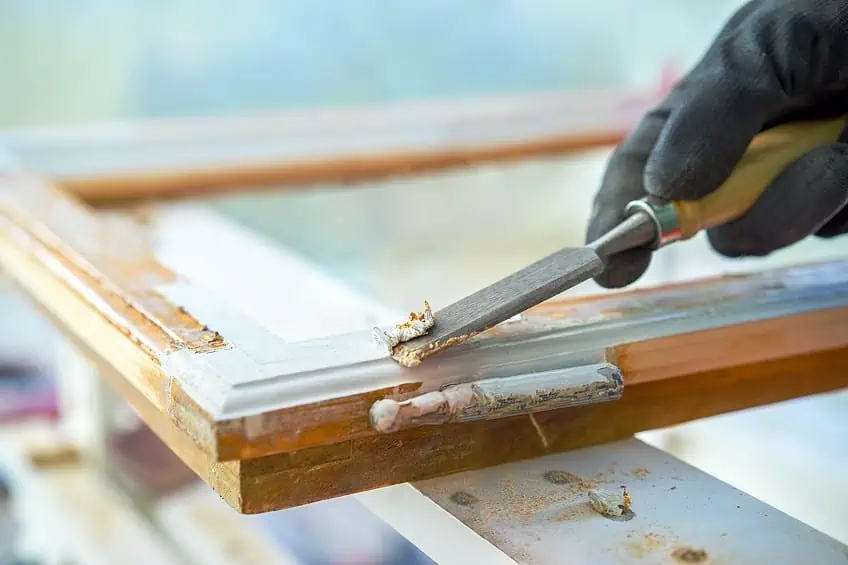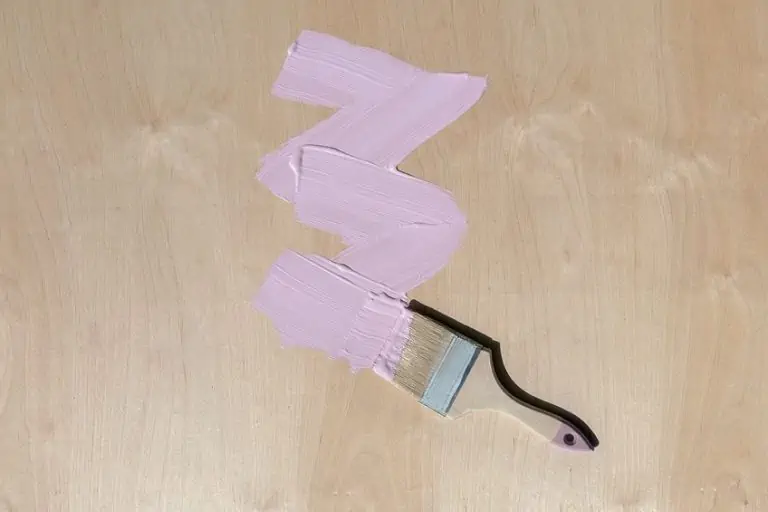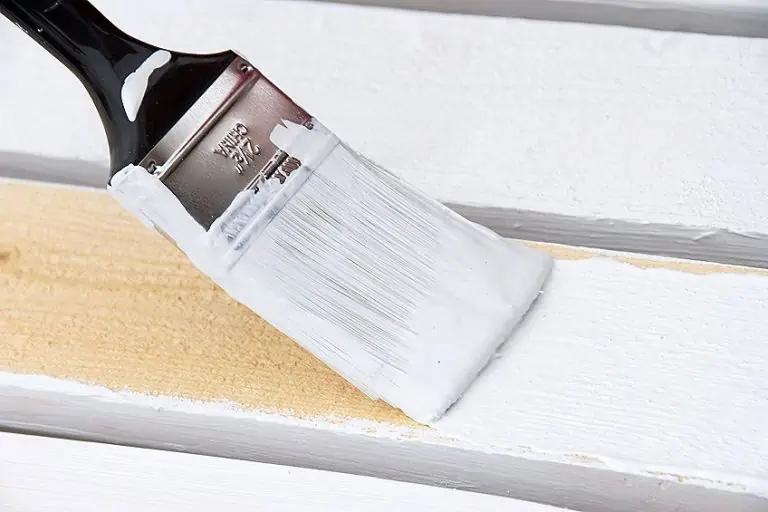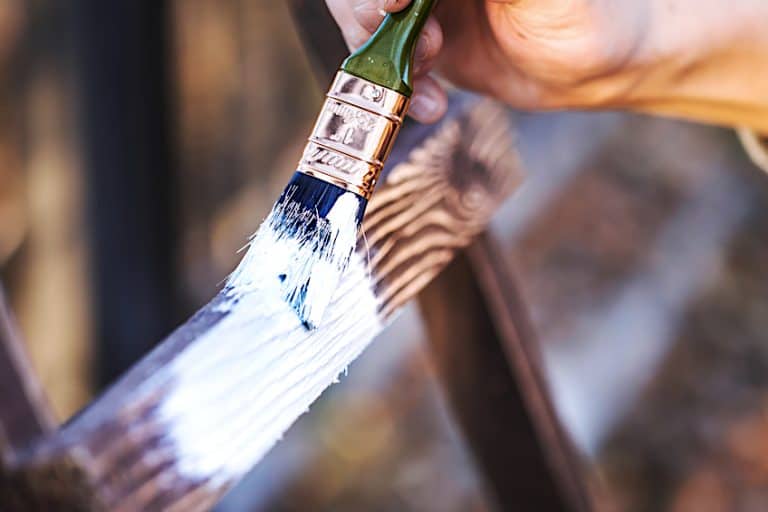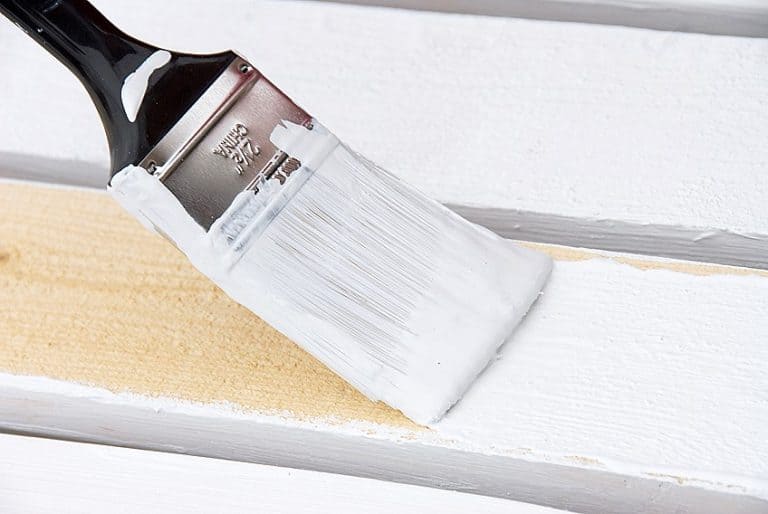How to Remove Spray Paint from Wood – An Easy-to-Follow Guide
There’s nothing worse than accidentally getting paint on something that wasn’t supposed to be painted. Whether you forgot to cover your favorite table, or you’ve managed to paint a part of your workpiece that you weren’t supposed to, it can be a nightmare to remove the paint without damaging your finish. Thankfully, there are a few useful tricks you can use to ensure that paint is removed from your workpiece without damaging it. Let’s have a look at how to remove spray paint from wood easily, while not tarnishing your precious finish.
Table of Contents
Why Would You Need to Remove Spray Paint from Wood?
Now, you might be asking yourself, “if my workspace is prepared, why would I need to remove spray paint from wood?”. Well, they’re called accidents for a reason, and things don’t always go exactly as we plan. Perhaps some of your painter’s tape came loose while you were working, or the nozzle of your sprayer malfunctioned.
Either way, you’re going to need to get that spray paint off your workpiece. Usually, it’s actually pretty easy to remove spray paint from a finish that has dried and cured completely. However, if your finish isn’t the type that cures and sets, removing paint using a solvent or even sanding the surface can result in your finish and workpiece being badly damaged.
There are loads of things that you can do to ensure that your workspace and workpiece are adequately prepared, but you can’t account for every possibility. This is why most professional woodworkers will always advise you to coat your workpiece in wood stain, resin, or other curing protective sealers in case a situation like this arises.
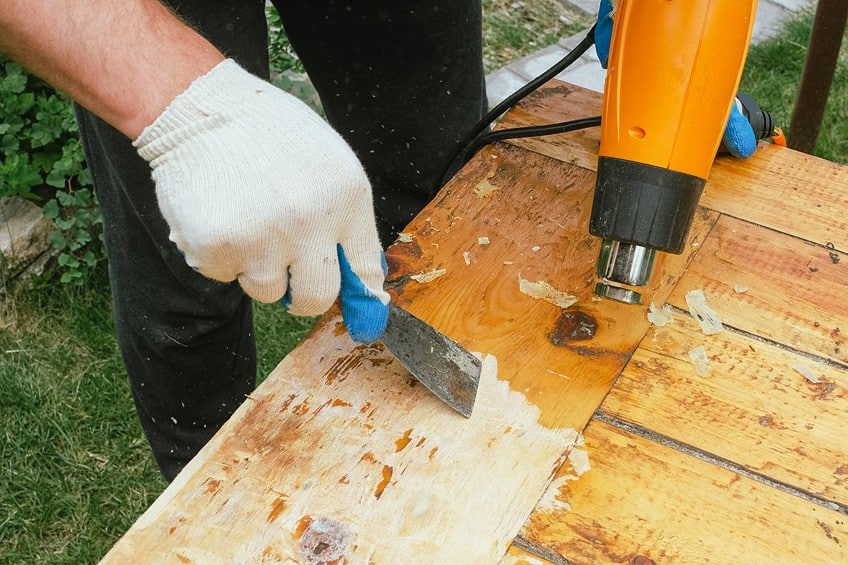
It’s likely that you’re either going to make a mistake, or that malfunction is going to occur with your sprayer. In both of these instances simply being mindful can go a long way in ensuring that your workpiece doesn’t get paint on it, but like we said previously, it’s pretty much impossible to account for every possibility, so what do you do when an accident does happen? The same thing you’d do to prepare for any other accident. Ensure that you have the knowledge, equipment, and skills to ensure that if an accident does occur, you have the means to respond and correct it immediately.
That’s why we’ve prepared a few short walkthroughs showing you how to remove spray paint from wood, what you will need, and why certain methods apply in certain scenarios.
Removing Spray Paint from Wood
As we mentioned previously, removing paint by force can cause quite a bit to some wooden surfaces. This being said, there are a few instances where some force might be the best way to go about things, but in most instances, you’ll need a gentler approach.
Here are a few methods you can try when attempting to remove unwanted paint from wooden surfaces.
Sanding Your Workpiece
Remember how we said that sanding might not always work? Well, let’s have a look at some of the instances where it will. Sanding the surface of your workpiece is a good idea if you have a nice thick layer of protective coating on the surface of your workpiece, or if your workpiece has yet to be finished. How do you go about it though? Paint is a surface coating, and if you’ve managed to get some on a workpiece unintentionally, it’s pretty easy to get off with some light sanding. Using fine-grit sandpaper, lightly sand the affected area in a reciprocal motion, stopping to check if you’ve reached the surface of your workpiece every once in a while. Once you have, it’s time to use some liquid.

If you’re using solvent-based paint like oil-based paint, you can apply some either directly to the surface or on a clean cloth and rub the affected area until the paint residue has been removed from the surface of your workpiece. If your paint is water-based and hasn’t had the opportunity to dry yet, some water and a good rubbing should work just fine too! Here is what you’ll need for this method:
- Sandpaper/power sander
- A clean cloth
- Solvent/water
- A set of gloves
- A face mask
Always Be Safe When Using a Power Sander
Power tool safety is something every woodwork enthusiast knows pretty well, but as time goes on and your skills develop, it’s easy to become complacent. Power sanders are powerful tools that can be hazardous if used incorrectly, so it’s always best to ensure that you double (and even triple) check your hardware before using it.
How do you ensure that your power sander is safe to use? The best way to ensure that your sander is safe to use is to check your power cable, ensure that your disk lock is working correctly, and ensure that the motor is working correctly. Check your power cable by ensuring that it is secure on both ends.
Check your sanding disk lock mechanism by attaching a disk (with the power off) and rotating it manually. Finally, check if your sander’s internal motor is in good working order by turning it on without a disk attached. If the casing heats up excessively, It could be time to replace or repair the unit.
Using Chemical Removers
Removing spray paint from wood can be made 10 times easier if you have the right chemical remover for the job. Different types of paint have different base elements that allow them to adhere to surfaces and provide much of their consistency.
There are three primary types of paint, namely water-based, acrylic-based, and oil-based paints.
Water-based paints generally don’t need chemical removers, all you need is some warm water, a cloth, and some elbow grease to get rid of this type of paint (and maybe a pressure washer if it’s really stubborn). Acrylic-based paints can be removed with a dedicated acrylic paint remover or some regular solvent-based cleaner. If you are trying to get rid of some oil-based paint, there’s only really one way to get rid of it. Using a solvent that has been designed to erode oil-based paints and some heat to lift the paint away from your workpiece. If you get oil-based paint on your hands some moderately hot water and elbow grease should do the job if you don’t want to get chemicals involved.
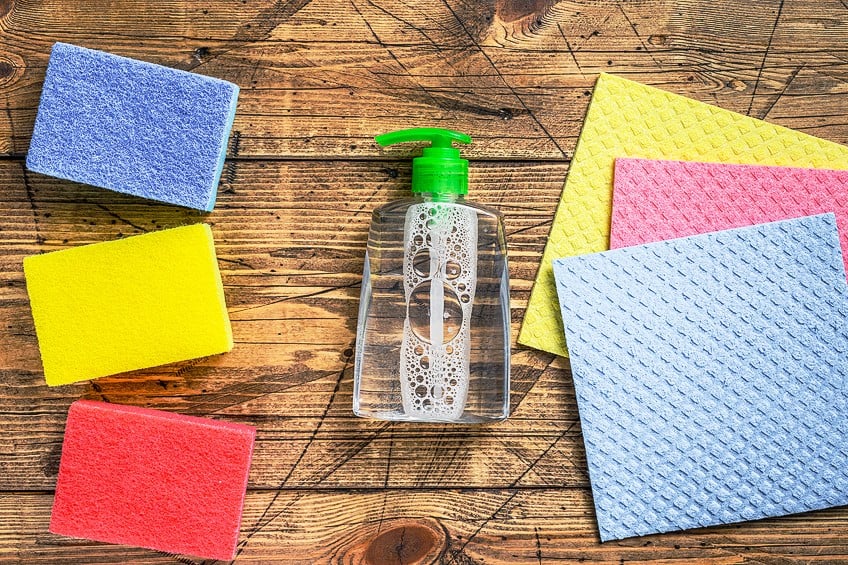
When working with any type of chemical remover or solvent, always ensure that you have the means and the knowledge to neutralize it beforehand. Some solvents like paint stripper need to be neutralized before paint or wood treatment is reapplied to the surface, so be sure to read the manufacturer’s instructions and be prepared!
- Solvent/dedicated paint remover
- Pressure washer (optional
- Water
- A clean cloth
- A set of gloves
- A face mask
Always Be Safe When Working with Chemical Removers
When using chemicals to clean up paint you should always ensure that you and your workspace are adequately prepared. When it comes to personal protection, wear gloves, eye protection, and a respirator mask to prevent inhalation of the solvent and any chemical burns/reactions should it come into contact with your skin.
As for your workspace, ensure that it is well-ventilated so that the fumes don’t accumulate in your immediate area.
If you’re unsure whether a chemical remover like solvent is suitable for the type of paint you’re working with, don’t risk it. Using chemicals without understanding how they interact with the base elements of your paint can prove to be hazardous, especially if you are working in a cramped workspace.

Finally, do your best not to over apply the chemical removers. It doesn’t take much paint stripper and/or solvent to remove some paint that has spilled and dried, especially on sheer surfaces like metal and plastic. Over-application can damage the surface of your workpiece and create unwanted fumes in your work area.
Using a Heat Gun
One of the best ways to ensure that paint is removed (especially those that dry using solvents) is to apply heat directly to the paint. Now, we don’t mean set your workpiece on fire or anything like that, but you can use a heat gun.
If you don’t have a heat gun available to you or don’t feel like getting one, a decently hot hair dryer can be used too.
How exactly do you use a heat gun to remove paint? Basically, paints that contain solvents tend to create a hard, textured layer when they dry. Solvent paints need to be applied at room temperature, as when they’re too hot or too cold they will not dry or cure. Even once they have dried or cured, extreme heat and/or cold can cause the paint to raise away from the surface of your workpiece.
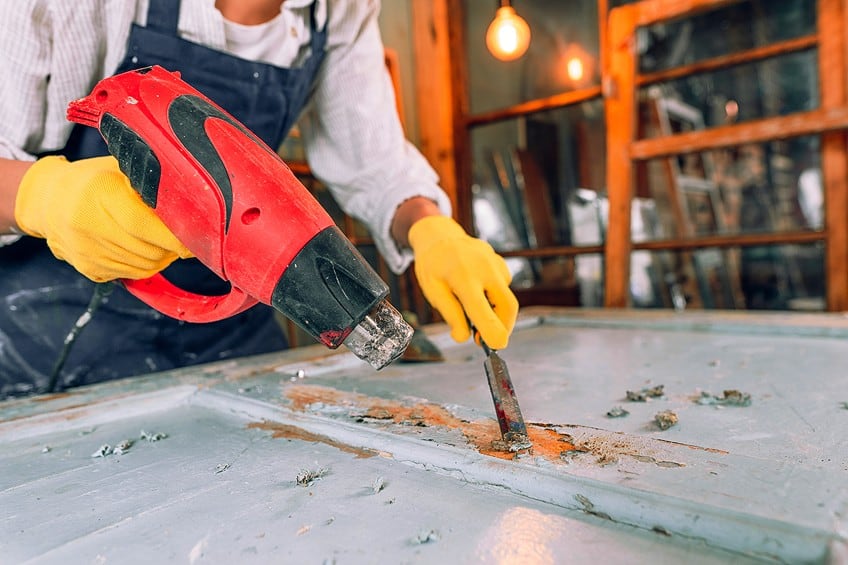
Therefore, all that you need to do is apply consistent heat to the affected area of your workpiece for a prolonged period of time and your paint will eventually begin to raise. Once the paint begins to bubble and raise, you’ll eventually be able to use a plastic lifter to scrape the paint away from the surface of your workpiece.
If you find there are still paint particles left on the surface of your workpiece, feel free to use some solvent to get rid of them.
Once again, a solvent is best suited for oil-based and tough acrylic paints, whereas latex-based paints can be removed with a little bit of water and some elbow grease! That being said, in most instances a heat gun will remove virtually all spray paint spills.
- A heat gun
- A plastic scraper
- Solvent/dedicated paint remover
- A clean cloth
- A set of gloves
- A face mask
Always Be Safe When Using a Heat Gun
Heat guns can prove to be hazardous if mishandled. You should always ensure that your heat gun is handled as instructed and as safely as possible. What does this mean? Essentially it means that you should ensure that when your heat gun is not being used (or is warming up) that the element is not facing wiring, wood, paper, or anything else that could catch on fire when heated.
Before using your heat gun you should also ensure that the wiring at both the handle of the gun at the end of the plug is in good working order. Since heat guns work using a coil system, any electrical malfunction can easily turn into quite a fire hazard. Be sure to check your wiring regularly, and avoid interacting with the hot end using your hands or face.
Besides ensuring that your wiring is firmly connected at both ends you should also ensure that your heat gun and its wiring are properly insulated. While the surfaces of the gun should be warm they should never be too hot, as this could mean a breach in the gun’s insulation. Also, ensure that your wiring is properly insulated and that it never comes into contact with water.
Tips for Success
You’ve probably noticed a trend when it comes to removing stubborn paint from surfaces. While one approach is good, using a combination of removal methods is usually what gets the job done quickly, efficiently, and effectively.
However, that doesn’t mean that these methods can be used interchangeably on all materials.
Some methods, like using chemicals and a sander, work better on wooden surfaces due to how paint interacts with wood. When the paint is attached to wood it needs to be removed either by force (using a sander) or with chemicals (paint stripper) because it tends to bond with the fibers of the wood, making it challenging to remove.

Accidentally getting paint on sheer surfaces like metals and plastics isn’t that big of a problem. These surfaces need to be prepared thoroughly for paint in order for it to adhere correctly, so unless you managed to accidentally spill self-etching paint on these surfaces you can use a heat gun or a light solvent to get rid of the paint. Knowing what works on your material is half the battle, and will save you lots of time and frustration down the line. That being said, regardless of which of these methods you use, always ensure that you’re wearing the appropriate personal protective gear and that your workspace is well-ventilated to ensure the best experience.
Now that you know how to strip spray paint from wood, what tools and chemicals are best for the job, how to use them effectively, and how to be safe while using them, it’s time for you to get out there and put your newfound knowledge to the test! Remember to always ensure that your workspace is well-ventilated, and that you are always wearing your personal protective equipment when working with these tools and substances.
Frequently Asked Questions
What Is the Best Way to Remove Spray Paint from Wood?
Wondering how to strip spray paint from wood? Arguably, the best approach is to use a combination of tools and chemicals to remove the paint. You could use a heat gun, some solvent, a paint scraper, and even some sandpaper, depending on how strong the stain is.
What Is Spray-on Paint Remover for Wood?
There are many ways to get rid of paint that has been spilled or intentionally applied to wood. One of the best ways to go about it is to use spray-on paint remover for wood. These products are essential solvents that raise the paint away from the wooden surface, allowing it to be scrapped or wiped away.
Can Old Paint Be Removed from Wood?
Yes, if your workpiece has had paint on it for a while, it can still be removed. There are lots of solvents and paint stripper products on the market for just such an occasion, but be sure that your wood piece is in decent condition before subjecting it to harsh chemicals.

I have been into woodworking since 2005 and woodturning since 2011. Because of my love for wood and woodworking, I started woodhappen.com to teach other enthusiasts about how to finish and seal wood, the best woodworking tools, the different types of wood, and everything else related to woodworking! Read more about me here.

